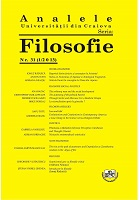THE RIM AS THE PEAK OF AWARENESS AND EMPEDOCLES AS ZARATHUSTRA: WISDOM IN THE ABYSS OF FIRE
THE RIM AS THE PEAK OF AWARENESS AND EMPEDOCLES AS ZARATHUSTRA: WISDOM IN THE ABYSS OF FIRE
Author(s): Charalampos MagoulasSubject(s): Metaphysics, Ancient Philosphy, Philosophy of Science
Published by: Editura Universitaria Craiova
Keywords: black hole; the rim; information; event horizon; Zarathustra;
Summary/Abstract: At the 17th International Conference on General Relativity and Gravitation in Dublin, Stephen Hawking admits he was wrong: even though he supported for some thirty years the theory that nothing can escape from inside a black hole, he just revealed that black holes allow after all the information to come out. Material and radiation, once trapped within the black hole, are lost. This area where everything – but not the information – disappears is framed by a boundary called event horizon. If the black hole is the abyss, the event horizon is the step next to the rim. If only information can escape from the abyss – let us call it “beyond” or simply “death” – there must be someone who collects this information, otherwise there is no information at all; someone who stands at the rim of the pit. The metaphysic allegory is already activated: a Zarathustra being the will to power and aiming at the final transvaluation of all values, stands before the event horizon, decides to betray life in favor of wisdom, jumps into the burning black hole, his Asha Vahishta, bravely enters the ground of negative – the land of not being – in order to reach the transmutation; it is not the transmutation of values but the transmutation of the principle which gives value to the values: the best truth of death communicates the substance of life. In that case, the definition of Zarathustra’s action is not but a methodological inversion: considering the black hole as an ontologically stable essence, we will produce the narrative of its opposite, the essence to be found outside the abyss. The abyss is a tool, a scheme, a metaphor. Although a construction or a hypothesis, the abyss is the privileged place of the divine loss. In the case of Zarathustra’s evaporation, we cannot help but feel the gap: who is going to narrate Zarathustra’s fight for eternal return? No one else could do this but a poet observing the action at the rim of the pit – e.g. Hölderlin or Arnold. However, according to Aristotle’s Metaphysics we should create the idea of a Third Man who observes the observation of the poet and stands away from the black hole. Thus, the semiotic reduction never ends. Is that nevertheless the meaning – i.e. product of decodification – of the eternal return?
Journal: ANALELE UNIVERSITĂȚII DIN CRAIOVA. SERIA FILOSOFIE
- Issue Year: 1/2013
- Issue No: 31
- Page Range: 177-185
- Page Count: 9
- Language: English

